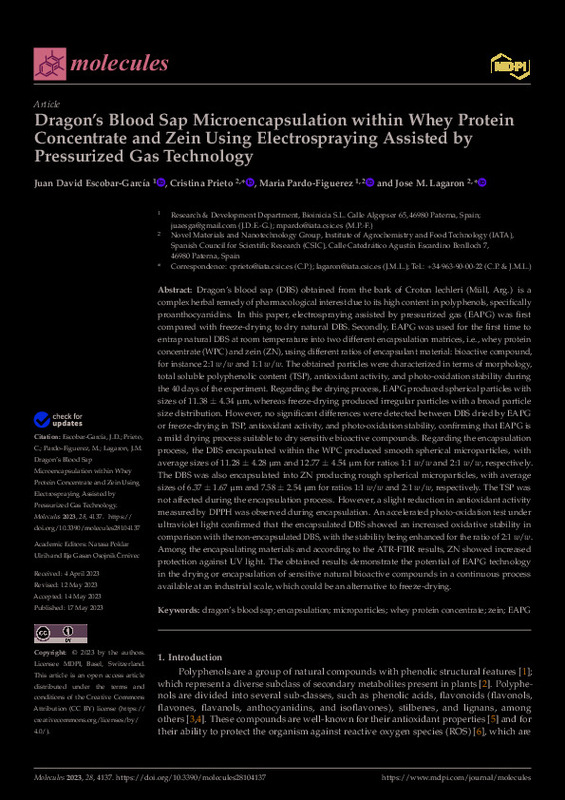|
Resumen:
|
[EN] Dragon's blood sap (DBS) obtained from the bark of Croton lechleri (Müll, Arg.) is a complex herbal remedy of pharmacological interest due to its high content in polyphenols, specifically proanthocyanidins. In this ...[+]
[EN] Dragon's blood sap (DBS) obtained from the bark of Croton lechleri (Müll, Arg.) is a complex herbal remedy of pharmacological interest due to its high content in polyphenols, specifically proanthocyanidins. In this paper, electrospraying assisted by pressurized gas (EAPG) was first compared with freeze-drying to dry natural DBS. Secondly, EAPG was used for the first time to entrap natural DBS at room temperature into two different encapsulation matrices, i.e., whey protein concentrate (WPC) and zein (ZN), using different ratios of encapsulant material: bioactive compound, for instance 2:1 w/w and 1:1 w/w. The obtained particles were characterized in terms of morphology, total soluble polyphenolic content (TSP), antioxidant activity, and photo-oxidation stability during the 40 days of the experiment. Regarding the drying process, EAPG produced spherical particles with sizes of 11.38 ± 4.34 µm, whereas freeze-drying produced irregular particles with a broad particle size distribution. However, no significant differences were detected between DBS dried by EAPG or freeze-drying in TSP, antioxidant activity, and photo-oxidation stability, confirming that EAPG is a mild drying process suitable to dry sensitive bioactive compounds. Regarding the encapsulation process, the DBS encapsulated within the WPC produced smooth spherical microparticles, with average sizes of 11.28 ± 4.28 µm and 12.77 ± 4.54 µm for ratios 1:1 w/w and 2:1 w/w, respectively. The DBS was also encapsulated into ZN producing rough spherical microparticles, with average sizes of 6.37 ± 1.67 µm and 7.58 ± 2.54 µm for ratios 1:1 w/w and 2:1 w/w, respectively. The TSP was not affected during the encapsulation process. However, a slight reduction in antioxidant activity measured by DPPH was observed during encapsulation. An accelerated photo-oxidation test under ultraviolet light confirmed that the encapsulated DBS showed an increased oxidative stability in comparison with the non-encapsulated DBS, with the stability being enhanced for the ratio of 2:1 w/w. Among the encapsulating materials and according to the ATR-FTIR results, ZN showed increased protection against UV light. The obtained results demonstrate the potential of EAPG technology in the drying or encapsulation of sensitive natural bioactive compounds in a continuous process available at an industrial scale, which could be an alternative to freeze-drying.
[-]
|
|
Agradecimientos:
|
This research was funded by the Valencian Innovation Agency (AVI) BIOENCAP project (reference number INNCAD00-18-31), H2020 EU FODIAC project (reference number 778388), and the H2020 EU projects CAPSULTEK (reference number ...[+]
This research was funded by the Valencian Innovation Agency (AVI) BIOENCAP project (reference number INNCAD00-18-31), H2020 EU FODIAC project (reference number 778388), and the H2020 EU projects CAPSULTEK (reference number 873827), grant PID2021-128749OB-C31 funded by MCIN/AEI/10.13039/501100011033 and by ERDF A way of making Europe. J.D.E.G. would like to thank the Spanish Ministry of Economy, Industry and Competitivity for his predoctoral grant (DI-6906). C.P. would like to thank the Valencian Ministry of Innovation, Universities, Science and Digital Society for her postdoctoral grant (CIAPOS/2021/45).
[-]
|








